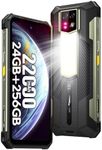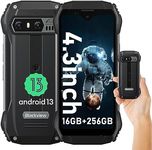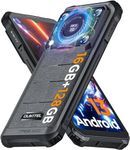Buying Guide for the Best Rugged Smartphones
When choosing a rugged smartphone, it's important to focus on durability and features that match your lifestyle or work environment. Rugged smartphones are designed to withstand tough conditions, making them ideal for outdoor enthusiasts, construction workers, or anyone who needs a device that can handle drops, water, and dust. To find the best fit, consider how and where you'll use the phone, and which features are most important for your daily needs.Durability Ratings (IP and MIL-STD)Durability ratings like IP (Ingress Protection) and MIL-STD (Military Standard) tell you how well the phone can resist water, dust, and shocks. IP ratings are usually shown as IP67 or IP68, where the first number is for dust protection and the second for water. MIL-STD-810G or 810H means the phone has passed military-grade tests for drops, temperature, and vibration. If you work in wet or dusty environments, or if you’re often outdoors, look for higher IP and MIL-STD ratings. If you just want extra peace of mind for occasional drops, a lower rating may be enough.
Battery LifeBattery life is how long your phone can run before needing a recharge. Rugged phones often have larger batteries to last through long workdays or outdoor adventures. Battery capacity is measured in milliampere-hours (mAh). Phones with 4000-5000mAh are good for regular use, while 6000mAh or more is better for heavy use or if you’re away from power sources for long periods. Think about how long you need your phone to last between charges and choose accordingly.
Display ProtectionDisplay protection refers to how tough the screen is against scratches and impacts. Many rugged phones use reinforced glass like Gorilla Glass. The higher the version (like Gorilla Glass 5 or 6), the better the protection. If you work in environments where your phone might get knocked or dropped, or if you’re often outdoors, a phone with stronger display protection is a smart choice.
Performance (Processor and RAM)Performance is about how fast and smooth your phone runs. The processor (CPU) and RAM (memory) are key here. Basic tasks like calls, texts, and light apps work fine with lower specs, but if you use demanding apps, multitask, or want your phone to stay fast over time, look for more RAM (4GB or more) and a newer processor. Match the performance to your typical usage to avoid frustration.
Camera QualityCamera quality matters if you need to take clear photos for work or personal use. Rugged phones often have simpler cameras, but some offer higher megapixels and features like night mode or wide-angle. If you just need basic documentation, a standard camera is enough. If you want to capture high-quality images or videos, look for higher megapixels and extra camera features.
Connectivity OptionsConnectivity options include things like 4G/5G support, Wi-Fi, Bluetooth, and sometimes extra features like NFC or dual SIM. If you need fast internet or plan to use your phone in remote areas, check for the latest network support. Dual SIM is useful if you travel or need separate work and personal numbers. Choose the options that fit your communication needs.
Physical Features (Buttons, Ports, Size)Physical features include things like programmable buttons, extra ports, and the overall size and weight of the phone. Some rugged phones have special buttons for quick access to apps or emergency calls, and extra ports for accessories. If you wear gloves or work in tough conditions, larger buttons and a grippy design can be helpful. Think about how you’ll handle the phone and what features will make your daily use easier.








